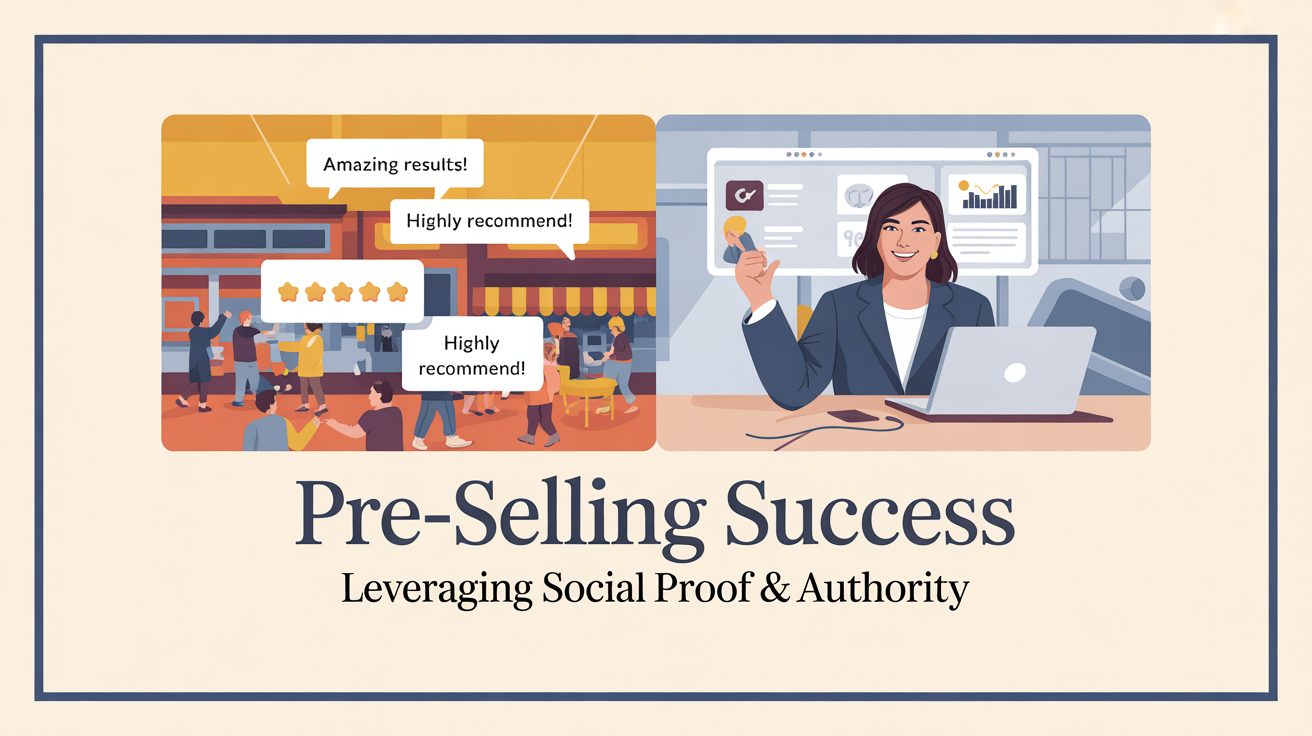In this article, you will learn how to use social proof and authority in your content to boost trust, credibility, and conversion rates before ever asking for the sale.
Introduction
If you’ve ever bought a product because “everyone else was raving about it” or because a trusted expert recommended it—you’ve experienced the power of social proof and authority in action.
These two forces are the backbone of successful pre-selling. When used together, they can eliminate skepticism, reduce buyer hesitation, and massively increase your chances of converting cold traffic into customers.
In this post, you’ll learn how to inject both authority and social proof into your pre-selling strategy—so your audience is sold on you long before you present the offer.
What Is Social Proof?
Social proof is the psychological phenomenon where people look to others to decide how to act.
In the world of internet marketing, this means your potential customer wants to know:
- “Do other people trust this person?”
- “Has this actually worked for someone like me?”
- “What do others say about this product?”
If you can answer these questions before pitching, you lower resistance and increase conversions.
Types of Social Proof You Can Use
Here are the main types of social proof that work great for pre-selling:
- Testimonials: Short quotes from happy users or clients
- Case Studies: In-depth breakdowns of real success stories
- User-Generated Content: Screenshots, social shares, or customer posts
- Ratings and Reviews: Especially important for digital products and SaaS
- “As Seen In” Mentions: Logos or media quotes that show third-party validation
- Audience Size or Usage Stats: “10,000 marketers use this funnel framework”
How to Use Social Proof in Pre-Selling Content
You don’t need to wait until the sales page to include social proof. Smart pre-sellers weave it throughout their content.
Examples:
- In a blog post: Add a callout quote from a reader who used your tips successfully.
- In an email: Mention that “300+ people grabbed this guide in the last 48 hours.”
- In a video: Show screenshots of results or DMs thanking you for your help.
- In a webinar: Share live comments or testimonials as you present.
Pro Tip: Add social proof early and often—but keep it natural and relevant to the topic at hand.
What Is Authority in Pre-Selling?
Authority is your perceived expertise or leadership in your niche.
When people believe you know what you’re talking about, they listen—and when they listen, they’re more likely to buy when you eventually make an offer.
You don’t need to be a global expert to build authority. You just need to show:
- You’ve done the thing you’re teaching
- You’ve helped others succeed
- You know your stuff and you’re honest about it
Ways to Build and Demonstrate Authority
Here are proven ways to position yourself as an authority in your pre-selling content:
- Tell your backstory—especially your struggles and journey
- Teach something valuable before asking for anything in return
- Publish consistently on a blog, YouTube channel, or email list
- Guest post or appear on podcasts in your niche
- Use data and references to support your claims
- Document your own results and progress (people love transparency)
Authority is less about how loud you are and more about how consistent, clear, and helpful your voice is.
Combining Social Proof + Authority
The real magic happens when you blend both social proof and authority into your content strategy.
Example Flow:
- Authority: You open your blog post with your personal story of solving a specific problem.
- Social Proof: You share how others got similar results using your approach.
- Authority: You explain the strategy with clarity and confidence.
- Social Proof: You link to a short testimonial or show screenshots.
- Soft CTA: You offer your lead magnet or next step.
This layered structure naturally builds confidence in your reader and leads them deeper into your funnel without pushing a sale.
Where to Use Social Proof and Authority in Your Funnel
| Funnel Stage | Where to Add Authority & Social Proof |
| Blog Content | Personal story, reader testimonials, data screenshots |
| Lead Magnet Page | Logos, endorsements, number of downloads or subscribers |
| Welcome Emails | Founder backstory, case studies, early user feedback |
| Nurture Emails | Tips mixed with proof of results (yours and others’) |
| Webinar/Video | Milestones, quotes from viewers, “what happened after” |
| Sales Page | Full testimonials, case studies, endorsements |
Mistakes to Avoid
Even though these tools are powerful, they can backfire if misused.
Don’t:
- Fake testimonials or exaggerate results
- Overhype your authority (“guru” language turns people off)
- Use irrelevant proof (focus on social proof from people similar to your target audience)
- Ignore story and context (data without narrative doesn’t resonate)
Use these tools authentically and in service of your reader’s transformation.
Final Thoughts
If you’re trying to pre-sell without social proof and authority, you’re fighting an uphill battle.
When your audience sees others getting results—and believes you’re the guide who can help them too—you don’t need aggressive pitches or hard closes.
You just need:
- Helpful content
- Strategic positioning
- And a few trust signals sprinkled in along the way
That’s what turns readers into subscribers, browsers into buyers, and skeptics into superfans.
Start using social proof and authority today and watch your pre-selling power go through the roof.

